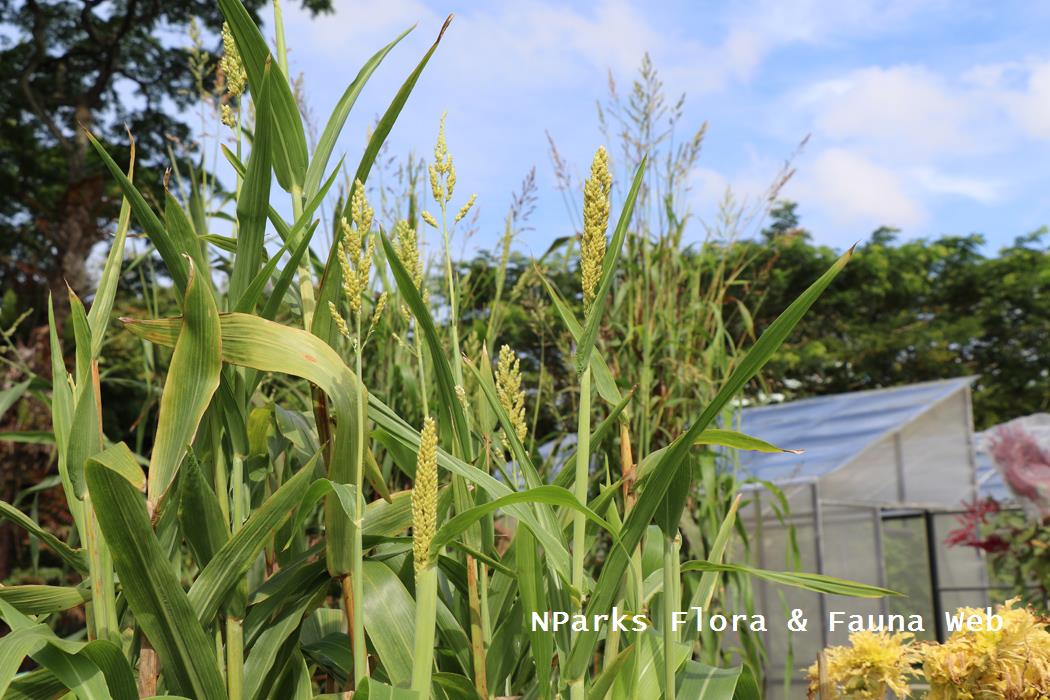
Back
Sorghum bicolor (L.) Moench
| Family Name: | Poaceae (Gramineae) |
| Synonyms: | Sorghum nigrum |
| Common Name: | Sorghum, Sweet Sorghum, Grain Sorghum, Great Millet, Broom Millet |
Name
Classifications and Characteristics
| Plant Division | Angiosperms (Flowering Seed Plants) (Monocotyledon) |
|---|---|
| Plant Growth Form | Grass or Grass-like Plant (Tall Grass (Poaceae)) |
| Lifespan (in Singapore) | Annual, Perennial |
| Mode of Nutrition | Autotrophic |
| Plant Shape | Columnar |
| Maximum Height | 0.5 m to 4 m |
Biogeography
| Native Distribution | Africa, Indian Subcontinent |
|---|---|
| Native Habitat | Terrestrial (Agricultural Land) |
| Preferred Climate Zone | Tropical, Sub-Tropical / Monsoonal |
| Local Conservation Status | Non-native (Horticultural / Cultivated Only) |
| CITES Protection | False |
Description and Ethnobotany
| Growth Form | An annual or short-lived perennial up to 0.5 - 4 m tall. |
|---|---|
| Foliage | Leaves are cauline, with base broadly rounded. Leaf blade measures from 30 - 100 cm long and 5 - 10 mm wide, glabrous and waxy. Leaf sheaths encircle the culms and have overlapping margins. |
| Flowers | Panicles up to 40 cm long, loose and open. Spikelets are sessile, measuring up to 6 mm long. Upper branches tend to droop. |
| Fruit | Caryopsis (seed) is exposed when mature. |
| Cultivation | The seed should be treated with fungicide and insecticide before sowing. It is susceptible to leaf diseases, such as anthracnose and leaf blight. |
| Etymology | The genus Sorghum is from the Italian name, sorgho. The specific epithet bicolor means two-coloured. |
| Ethnobotanical Uses | Edible Plant Parts : Edible Fruits Food (Fruit or Vegetable): The grains are ground into flour. Agriculture - Forestry: It is fermented and processed into silage for use as animal feed during the winter. Cattle also graze on them and their crop residues. |
Landscaping Features
| Landscape Uses | Flowerbed / Border |
|---|---|
| Thematic Landscaping | Economic Garden |
| Plant & Rootzone Preference or Tolerance Remarks | It can tolerate short term flooding but not prolonged waterlogged conditions. |
Fauna, Pollination and Dispersal
| Fauna Pollination Dispersal Associated Fauna | Bee-Attracting |
|---|---|
| Pollination Method(s) | Abiotic (Self-Pollinated), Biotic (Fauna) (Insects (Bee)) |
Plant Care and Propagation
| Light Preference | Full Sun |
|---|---|
| Water Preference | Moderate Water |
| Plant Growth Rate | Moderate |
| Rootzone Tolerance | Drought Tolerant, Well-Drained Soils, Fertile Loamy Soils |
| Potential Problems | Birds and rodents. Weeds can be a problem too, therefore regular weeding is required to reduce competition for space and growth. |
| Diseases | Leaf diseases. |
| Pest(s) | Vertebrates (Herbivores) |
| Propagation Method | Seed |
Foliar
| Foliage Retention | Evergreen |
|---|---|
| Mature Foliage Colour(s) | Green |
| Mature Foliage Texture(s) | Smooth, Powdery / Waxy Bloom |
| Prominent Young Flush Colour(s) | Green |
| Foliar Type | Simple / Unifoliate |
| Foliar Arrangement Along Stem | Alternate |
| Foliar Attachment to Stem | Sessile |
| Foliar Shape(s) | Non-Palm Foliage (Linear) |
| Foliar Venation | Parallel |
| Foliar Margin | Entire |
| Foliar Apex - Tip | Acuminate |
Floral (Angiosperm)
| Flower Colour(s) | Red |
|---|---|
| Flower Grouping | Cluster / Inflorescence |
| Flower Location | Terminal |
| Inflorescence Type | Panicle |
Fruit, Seed and Spore
| Fruit Classification | Simple Fruit |
|---|---|
| Fruit Type | Indehiscent Dry Fruit , Caryopsis / Grain |
Image Repository
Others
| Master ID | 32751 |
|---|---|
| Species ID | 7163 |
| Flora Disclaimer | The information in this website has been compiled from reliable sources, such as reference works on medicinal plants. It is not a substitute for medical advice or treatment and NParks does not purport to provide any medical advice. Readers should always consult his/her physician before using or consuming a plant for medicinal purposes. |




